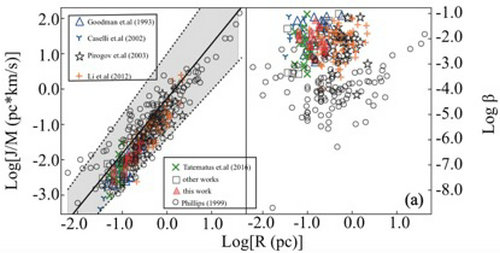Star forms in dense cores, which are the densest region in molecular clouds. Angular momentum is a basic parameter of dense cores and plays an important role in the evolution of dense cores. The physical properties of dense cores are intimately linked to the amount of angular momentum they carry.
The angular momentum problem is one of the three classical problems of star formation (magnetic field problem, turbulence problem and angular momentum problem). The so-called "angular momentum problem" refers to the fact that the angular momentum of the celestial objects leading to new stars is several orders of magnitude larger than that of the resulting stars. In terms of the scale of dense cores and stars, prestellar cores have angular momentum at least three times greater than that of stars. From dense cores to stars, the current researches still have no clear conclusions on the explanation of the dissipation of angular momentum.
A new study led by Dr. Xuefang Xu, Prof. Di Li and Prof. Yu Dai from National Astronomical Observatories of Chinese Academy of Sciences (NAOC) verifies the role of angular momentum in 6 northern molecular clouds: the angular momentum at the sub-light-year scale no longer affects the overall collapse of the dense cores.
This study was recently published in Astrophysical Journal.

Figure: Specific angular momentum (J/M) and the ratio of rotational to gravitational energy (β) as a function of R for the cores in the present study together with those previously observed.
The paper can be accessed at 10.3847/1538-4357/ab9a45

Address: 20A Datun Road, Chaoyang District, Beijing, China code: 100012
Tel: 010-64888708 E-mail: naoc@nao.cas.cn

